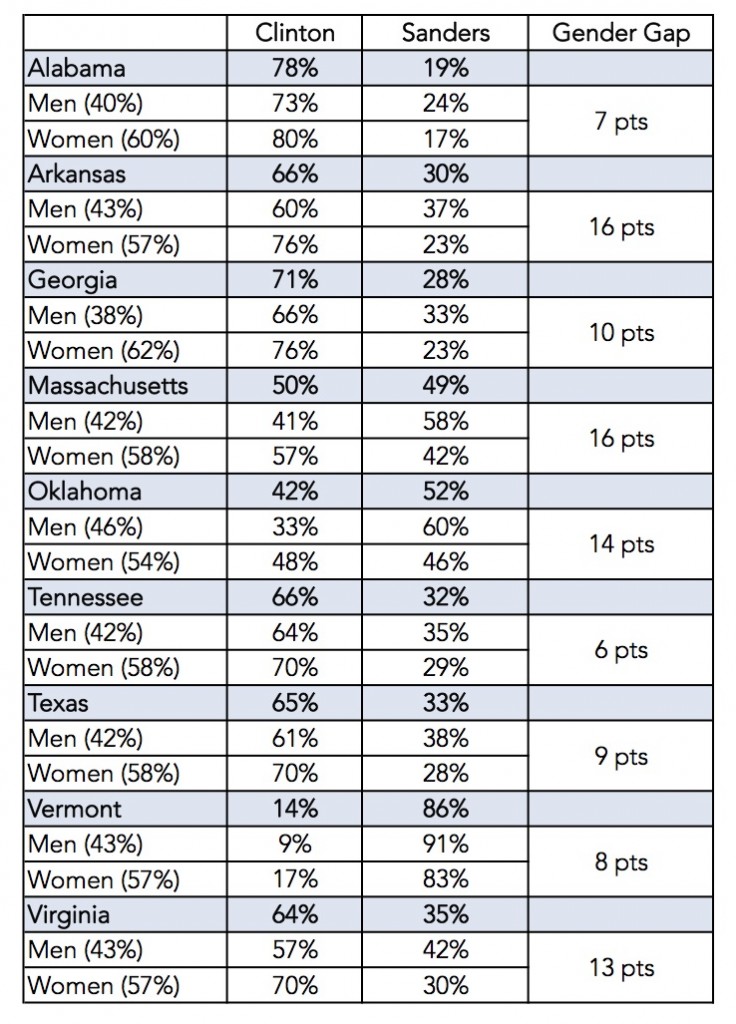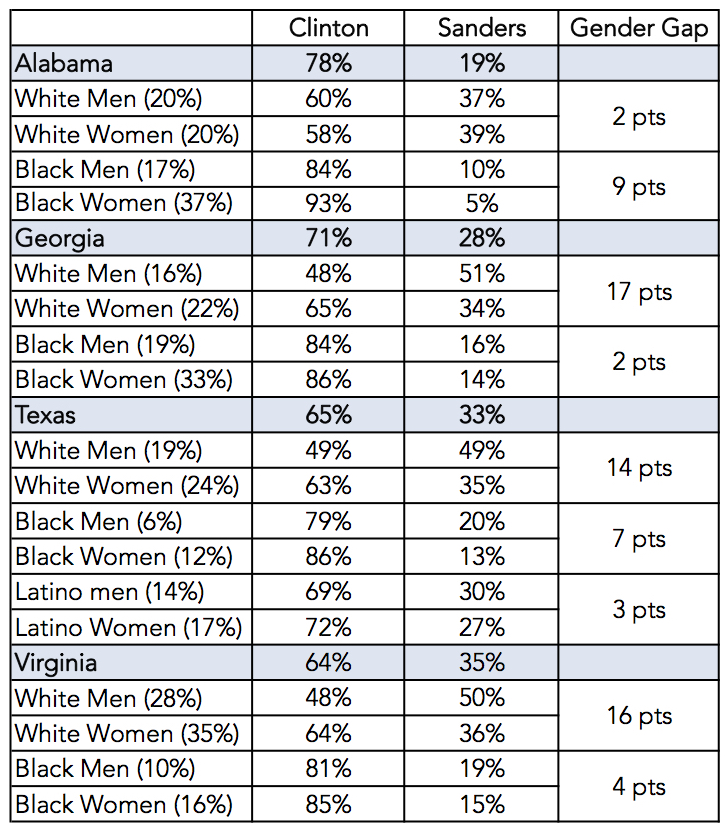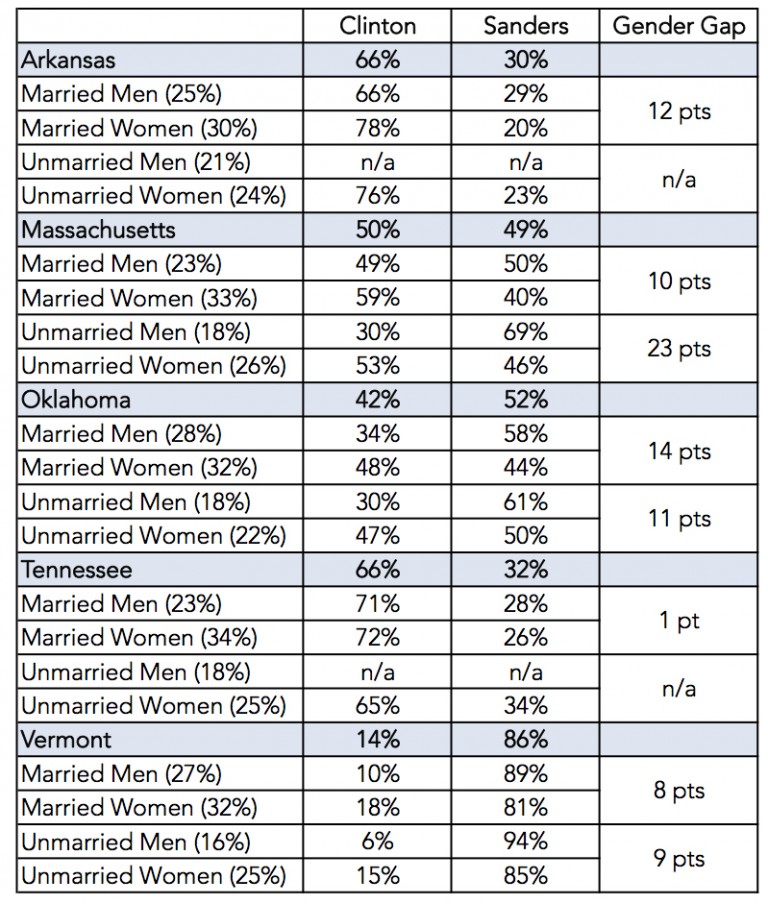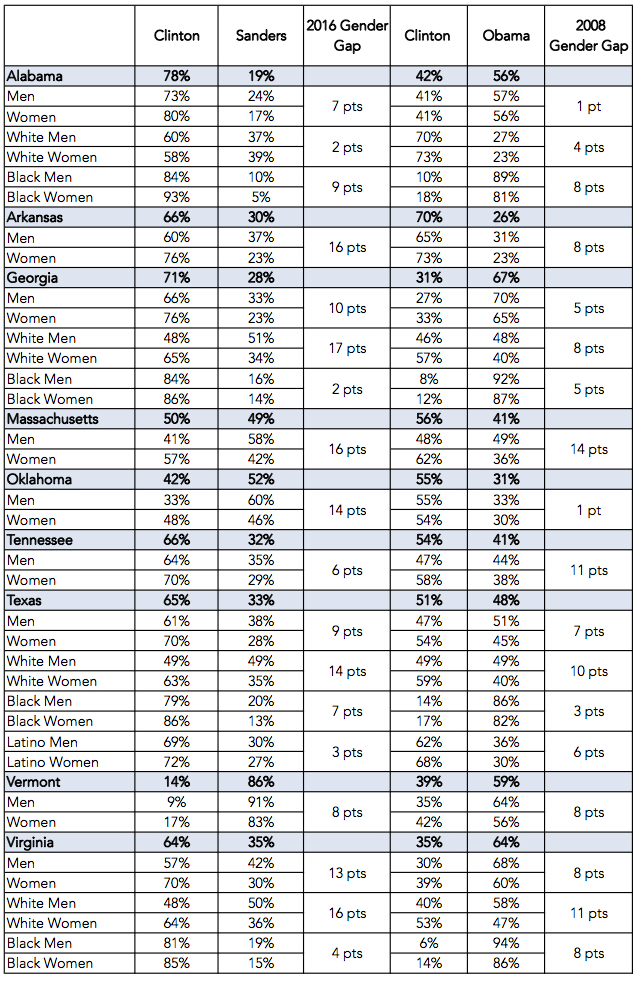Women were HUUUGE in Hillary Clinton’s Super Tuesday Success
 In April 2015, the Barbara Lee Family Foundation (BLFF) and the Center for American Women and Politics (CAWP) launched Presidential Gender Watch 2016, a project to track, analyze, and illuminate gender dynamics in the 2016 presidential election. With the help of expert scholars and practitioners, Presidential Gender Watch worked for 21 months to further public understanding of how gender influences candidate strategy, voter engagement and expectations, media coverage, and electoral outcomes in campaigns for the nation’s highest executive office. The blog below was written for Presidential Gender Watch 2016, as part of our collective effort to raise questions, suggest answers, and complicate popular discussions about gender’s role in the presidential race.
In April 2015, the Barbara Lee Family Foundation (BLFF) and the Center for American Women and Politics (CAWP) launched Presidential Gender Watch 2016, a project to track, analyze, and illuminate gender dynamics in the 2016 presidential election. With the help of expert scholars and practitioners, Presidential Gender Watch worked for 21 months to further public understanding of how gender influences candidate strategy, voter engagement and expectations, media coverage, and electoral outcomes in campaigns for the nation’s highest executive office. The blog below was written for Presidential Gender Watch 2016, as part of our collective effort to raise questions, suggest answers, and complicate popular discussions about gender’s role in the presidential race.
In her quest to win the Democratic nomination for president, Hillary Clinton has made overt appeals to women voters, whether by emphasizing issues of particular importance to women, sharing her own experiences (and challenges) as a woman, or reaching female audiences through women-focused media or women surrogates. Some have criticized these tactics as “playing the gender card,” but Clinton is not alone in seeking support from women voters. Why? Because women voters outnumber and outvote their male counterparts. They are also more reliably Democratic voters than men and have been so since 1980.

Women demonstrated their dominance in the Democratic electorate on Super Tuesday. Exit polls showed that women were a greater proportion than men of the Democratic voters in every primary contest, with an average gap of about 16 points. In Georgia, for example, where Clinton bested Sanders by 43 points, exit polls estimate that women were 62% of the Democratic electorate and men were just 38% of Democratic voters. That gap, while it varies in size, is evident among black, white, and Latino voters, as well as among married and unmarried voters in nearly all states that held primary elections this week.
Women also voted differently than their male counterparts in Tuesday’s Democratic primaries. There was a gender gap in vote choice – which measures the difference between women and men’s support for the winning candidate – in every contest, ranging from 6 to 16 points. Across the 13 contests where exit polls are available, the average size of the gender gap was 11.1 points. In all of these cases, women were more likely than men to support Hillary Clinton. Moreover, Clinton beat Sanders among women voters in all but one state – Vermont – where 83% of women and 91% of men supported their home state senator. In Oklahoma, where Sanders won overall, women were nearly split, with Clinton earning 48% of women’s support versus 46% women who voted for Sanders; 60% of men supported Sanders there, while just 33% of men voted for Clinton. Finally, women could be credited with tilting the Massachusetts primary in Clinton’s favor. Clinton won there by a 1-point margin, but with a 16-point gender gap; 57% of women and 41% of men in Massachusetts cast their ballots for Clinton. Though Sanders support by gender nearly mirrored Clinton’s, women made up 58% of the Democratic electorate in the state.
Clinton’s support among women was strongest among women of color, particularly black women, who are the most reliably Democratic voters of any race/gender subgroup. Clinton won between 84% and 93% of black women’s votes in the states where race/gender exit poll findings were released. In Texas, the only state where data on Latino support by gender was released, Clinton won 72% of Latinas’ votes. The gender gaps in Clinton’s support among black and Latino voters are smaller, on average, than those among white voters, due to her overall dominance over Sanders among these groups. According to aggregate exit polls of Super Tuesday states, Clinton won 66% of all Latino voters and about 80% of all black voters.
A Female Firewall?

As many have noted, Clinton’s support among black and Latino voters provided a “firewall” to Sanders’ success on Super Tuesday. But women voters also contributed to that firewall. For example, Clinton won the majority of white voters overall in all four states where race by gender polling data were provided (Alabama, Georgia, Texas, and Virginia), despite Sanders’ winning among white men in three of those states (Georgia, Texas, and Virginia).
Tuesday’s exit polls also break down voters by gender and marital status in the remaining five primary states, giving some additional insights into the gender gap in narrower cohorts. While Sanders has been performing better with unmarried than married voters overall, in large part because they skew younger in age, gender gaps among both groups are evident in every state where the data was released. More clearly, Clinton cut into Sanders’ support among unmarried voters by winning over more unmarried women than men. (Remember, unmarried women make up a larger proportion of the Democratic electorate than unmarried men.) Take Massachusetts, for example, where there was a 23-point gender gap in support among unmarried voters, the largest gender gap in any exit poll data from Tuesday’s contests; 53% of unmarried women and 30% of unmarried men voted for Clinton, while 69% of unmarried men voted for Sanders. Similarly in Oklahoma, where Sanders won by 10 points overall, there was an 11-point gap among unmarried voters; 61% of unmarried men and just 50% of unmarried women voted for Sanders. The only Super Tuesday state where Sanders won the majority of unmarried women’s support was Vermont, where 86% of all voters – and 85% of unmarried women – voted for him.

These data indicate that women were more likely than men to support Clinton across diverse demographic groups in Tuesday’s contests; even when the majority of men and women in those groups supported Sanders, women did so in lesser numbers than men. This difference is particularly important in close contests, like in Massachusetts, and is especially significant when women voters outnumber men, as they do in Democratic primaries.
Are Gender Differences New in Democratic Primaries?
But are the gender differences in Clinton’s support because she is a woman? Dr. Barbara Norrander recently explained that gender gaps in vote choice were evident in about one-quarter of all Democratic primaries from 1980-2000, all contests where only men competed. In 2008, when Clinton first sought the nomination, there was an average gender gap of nine points across all Democratic contests. That year, as in 2016, Clinton earned greater support from women then men overall, even in contests where Barack Obama won the majority of voters in both groups (see table below).
But here is the most significant difference: unlike in 2008, when Barack Obama dominated Clinton among black women, Clinton has thus far been successful in winning strong majorities among these women in 2016. Just look again at Tuesday’s results. Clinton won 93% of black women’s votes in Alabama, the same state where she won just 18% of black women’s votes in 2008 (a year when Obama won 81% of black women). In Georgia, Clinton won 86% of black women’s votes on Tuesday, compared to just 12% in 2008. Clinton won 86% and 85% of black women’s votes on Super Tuesday in Texas and Virginia respectively, states where she won less than 20% of black women’s support just 8 years ago. As many have noted, Clinton’s ability to secure support from the “Obama coalition” is essential to her primary success thus far. Women of color, and black women specifically, are an important part of that coalition. Clinton’s advantage among these and other groups of women expands her margins of success against Bernie Sanders overall.
As we look beyond Super Tuesday, Clinton will rely upon women’s support across groups. But, even more, she will need women across age, race, and ethnic groups to turn out in high numbers in the general election. That means engaging and energizing women voters, but doing so in ways that recognize the diversity among them. As all these data show, women are not a monolithic bloc when it comes to who they vote for and in what numbers. But, even more, they are not monolithic in the issues that motivate their votes, and the experiences they bring to the ballot box. Maintaining and expanding support among women voters, then, means addressing that complexity in messaging, policy proposals, and outreach. All candidates have more work to do on that front, but – if numbers are any indicator – Clinton seems to have a head start.



